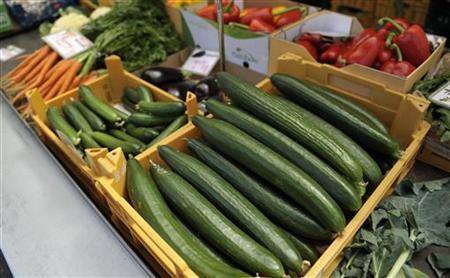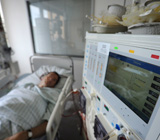Three of four cucumber samples that tested positive for E. coli O104 in Germany were grown on two organic farms in Spain.
The news comes as the number of victims suffering from hemolytic uremic syndrome reached 214 out of approximately 600 ill, and at least four dead.
Kai Kupferschmidt writes in Science Insider today that authorities in Hamburg announced they had isolated the bacterium that is likely causing the outbreak, E. coli O104:H4 , from four cucumbers. Three of the samples came from a big market in Hamburg that sells to greengrocer’s shops as well as restaurants and caterers. Those .jpg) cucumbers came from two organic producers in Spain. Scientists had speculated in the last few days that manure from infected animals used on an organic farm might have spread the bacteria to vegetables. A fourth sample came from a restaurant, and it was not immediately clear where that cucumber had been grown. After the announcement, stores started taking Spanish cucumbers off the shelves.
cucumbers came from two organic producers in Spain. Scientists had speculated in the last few days that manure from infected animals used on an organic farm might have spread the bacteria to vegetables. A fourth sample came from a restaurant, and it was not immediately clear where that cucumber had been grown. After the announcement, stores started taking Spanish cucumbers off the shelves.
Consumers had already been hesitant about vegetables since scientists at RKI and the Federal Institute for Risk Assessment announced the results of a first case-control-study on Wednesday evening: Women who had become infected with EHEC were a lot more likely to have eaten raw tomatoes, cucumbers, and lettuce in the days before falling ill than women who had not fallen ill.
The scientists used a detailed questionnaire to ask 25 female EHEC patients and 96 women living in the same areas about what they had eaten in the days before the outbreak. Only women were included in the study because they have fallen ill more often than men in the outbreak. "It also strengthened the results of the study, because it meant that we could ignore all sex-specific differences in eating habits," says Gérard Krause, head of the department for infectious diseases epidemiology at RKI.
A statistical analysis revealed that 92 % of the women who had become infected had previously eaten tomatoes. Only about 60% of healthy women had done so. "For something that people eat so frequently, this is a big difference," says RKI expert Klaus Stark. The results for cucumbers and lettuce were similar but slightly smaller. All three results were statistically significant. The experts advised Germans, particularly in the north, not to eat any raw tomatoes, cucumbers, or lettuce until further notice.
That advice remains in place. "It is certainly a possibility that more than one of these foods is responsible," says Reinhard Burger, president of RKI. Scientists also want to  be sure that the results from Hamburg are confirmed in another lab.
be sure that the results from Hamburg are confirmed in another lab.
Kurt-Henning Klamoth, president of the German Farmers Federation (DBB) accused the media of scaremongering and condemned speculation that the illness has been spread through organic fertilizers.
Spain is Germany’s second biggest supplier of cucumbers within the European Union, sending 179,500 tonnes of the vegetable to Germany in 2009, according to the Federal Office for Agriculture.
.jpg) cucumber deliveries while stressing there is no proof that the EHEC entered Germany through Spanish cucumbers.
cucumber deliveries while stressing there is no proof that the EHEC entered Germany through Spanish cucumbers.
.jpg) 80% of the confirmed cases were in females and 45% were in people aged between 15-24 years (range 7 to 53).
80% of the confirmed cases were in females and 45% were in people aged between 15-24 years (range 7 to 53)..jpg) cucumbers came from two organic producers in Spain. Scientists had speculated in the last few days that manure from infected animals used on an organic farm might have spread the bacteria to vegetables. A fourth sample came from a restaurant, and it was not immediately clear where that cucumber had been grown. After the announcement, stores started taking Spanish cucumbers off the shelves.
cucumbers came from two organic producers in Spain. Scientists had speculated in the last few days that manure from infected animals used on an organic farm might have spread the bacteria to vegetables. A fourth sample came from a restaurant, and it was not immediately clear where that cucumber had been grown. After the announcement, stores started taking Spanish cucumbers off the shelves. be sure that the results from Hamburg are confirmed in another lab.
be sure that the results from Hamburg are confirmed in another lab. Cornelia Pruefer-Storcks.
Cornelia Pruefer-Storcks. But the German reference laboratory for EHEC in Wernigerode has so far identified the serotype of EHEC in stool samples from five patients as O104.
But the German reference laboratory for EHEC in Wernigerode has so far identified the serotype of EHEC in stool samples from five patients as O104.
.jpg) The outbreak, thought to have been spread through contaminated vegetables, is unusual in that it has affected mainly adults.
The outbreak, thought to have been spread through contaminated vegetables, is unusual in that it has affected mainly adults. .jpg) while a further 50 people were ill with mild symptoms of EHEC.
while a further 50 people were ill with mild symptoms of EHEC. 2012. A "traffic light" scheme will show which eateries are spick-and-span — and which have nasties lurking under the cupboards.
2012. A "traffic light" scheme will show which eateries are spick-and-span — and which have nasties lurking under the cupboards..jpg) national association of consumer initiatives said.
national association of consumer initiatives said.